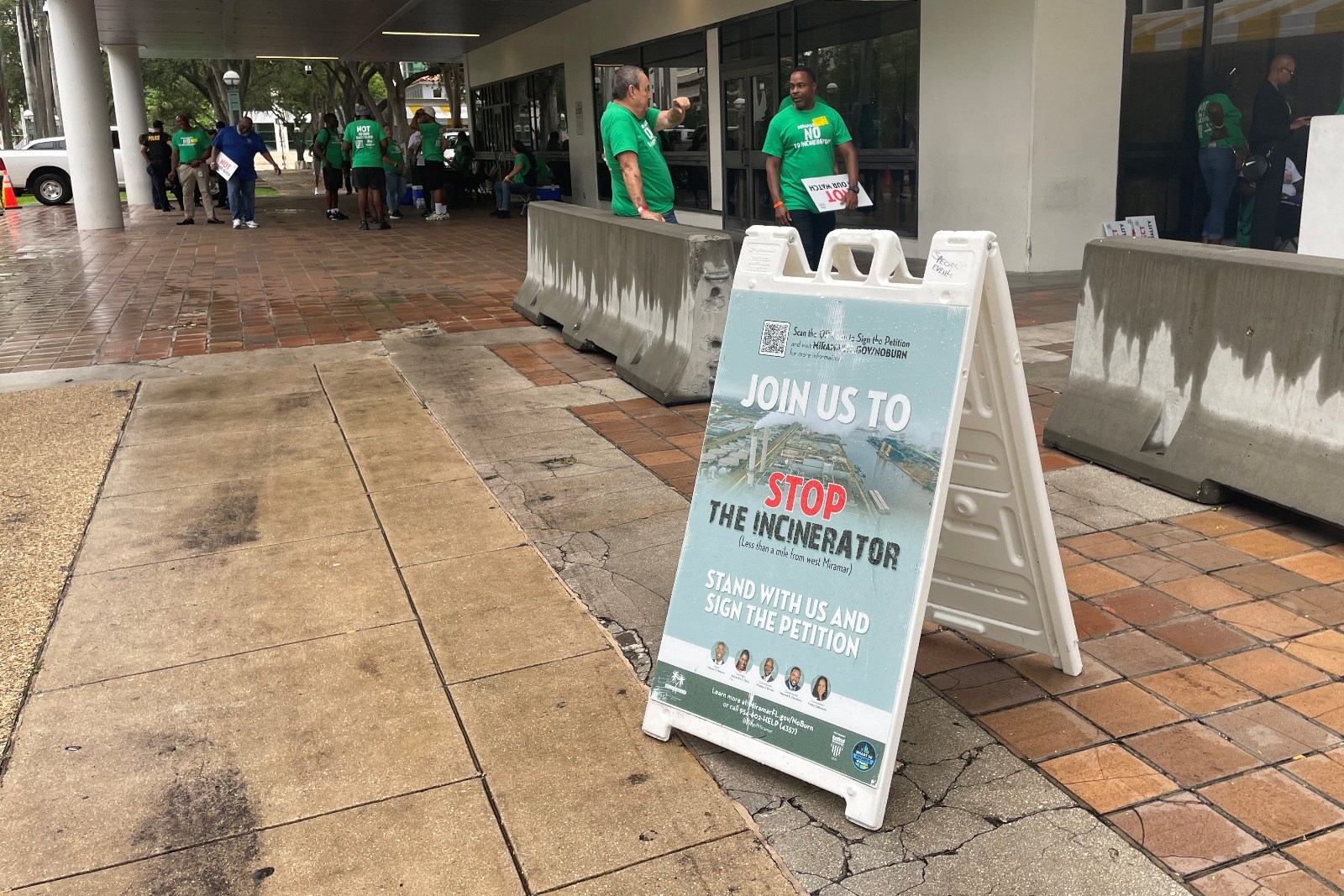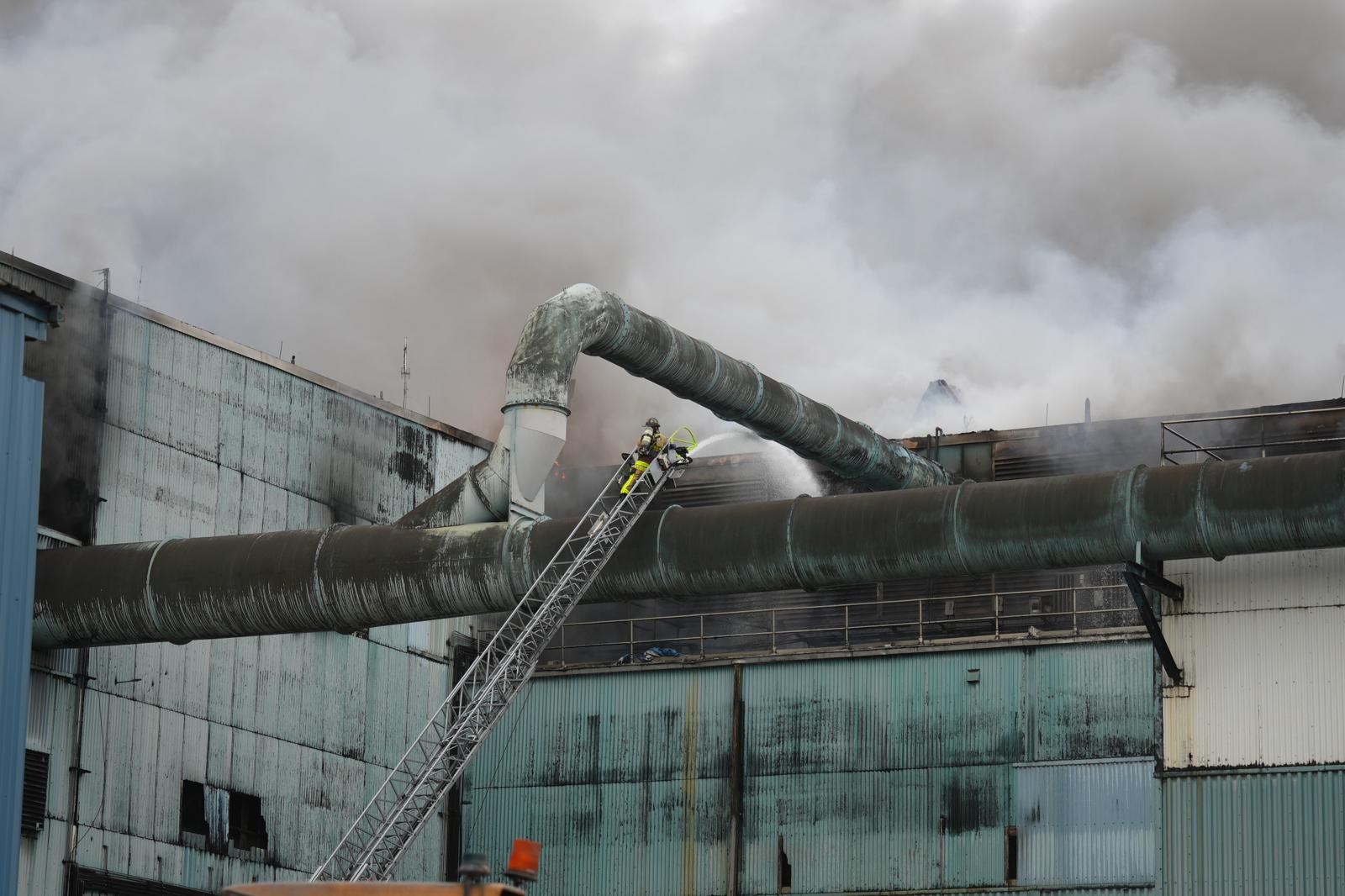In Florida, officials and communities clash over where to build the nation’s largest trash incinerator

When leaders of Florida’s most populous county met in September to pick a site for what could become the nation’s largest trash incinerator, so many people went to the government center to protest that overflow seating spilled into the building’s atrium.
“MIRAMAR SAYS NO TO INCINERATOR! NOT IN OUR BACKYARD,” read green T-shirts donned by some attendees who wanted to stop the new industrial waste facility — capable of burning up to 4,000 tons of garbage a day — from being built near their homes.
Residents feared the site would not only sink their property values and threaten the environment, but also potentially harm people’s health.
Even more, the locations appeared to have been selected in a way that worried civil rights and environmental advocacy groups. All four sites considered that day were in or near some of the region’s most diverse communities, and the state is arguing in federal court that race should not be a consideration in permitting industries that pollute the environment.
“Historically, communities of color have suffered the impacts of toxic plants near our cities, affecting our health and well-being,” Elisha Moultrie, a 30-year Miramar resident and committee leader with the Miami-Dade NAACP, told the county commissioners.
It’s “environmental injustice and racial injustice,” she said.
Daniel Chang / KFF Health News
Miami-Dade leaders see a different challenge: the need to effectively manage trash. The county produces nearly double the national average per person of garbage, in part due to one of the region’s major industries: tourism.
Yet, throughout 2024, Miami-Dade’s elected officials delayed a decision on where to build the planned $1.5 billion incinerator, as the county mayor and commissioners wrestled with politics. County leaders are scheduled to vote on a new site in February.
“There is no perfect place,” Miami-Dade Mayor Daniella Levine Cava said in a recent memo to county leaders.
The conundrum unfolding in South Florida is indicative of what some see as a broader trend in the national fight for environmental justice, which calls for a clean and healthy environment for all, including low-wealth and minority communities. Too often land inhabited by Black and Hispanic people is unfairly overburdened with air pollution and other emissions from trash incinerators, chemical plants, and oil refineries that harm their health, said Mike Ewall, director of Energy Justice Network, a nonprofit that advocates for clean energy and maps municipal solid waste incinerators.
“All the places that they would consider putting something no one wants are in communities of color,” he said.
More than 60 municipal solid waste incinerators operate nationwide, according to data from Energy Justice. Even though more than 60 percent of incinerators are in majority-white communities, those in communities of color have more people living nearby, burn more trash, and emit more pollutants, Ewall said.
And in Florida, six of the nine existing incinerators are in places where the percentages of people of color are higher than the statewide average of 46 percent, according to data from the Environmental Protection Agency’s EJScreen, an online tool for measuring environmental and socioeconomic information for specific areas.
Before Miami-Dade County’s old trash incinerator burned down in February 2023, the county sent nearly half of its waste to the facility. Now, the county is burying much of its trash in a local landfill or trucking it to a central Florida facility — an unsustainable solution.
Joe Kilsheimer, executive director of the Florida Waste-to-Energy Coalition, a nonprofit that advocates for owners and operators of trash incinerators, acknowledges that choosing a location is hard. Companies decide based on industry-accepted parameters, he said, and local governments must identify strategies to manage waste in ways that are both safe and efficient.
“We have an industrial-scale economy that produces waste on an industrial scale,” Kilsheimer said, “and we have to manage it on an industrial scale.”
Florida burns more trash than any other state, and at least three counties besides Miami-Dade are considering plans to build new facilities. Managing the politics of where to place the incinerator has especially been a challenge for Miami-Dade’s elected officials.
In late November, commissioners in South Florida considered rebuilding the incinerator where it had been for nearly 40 years — in Doral, a predominantly Hispanic community that also is home to Trump National Doral, a golf resort owned by the president-elect less than 3 miles from the old site. But facing new opposition from the Trump family, the county mayor requested delaying a vote that had been scheduled for December 3.
President Joe Biden created a national council to address inequities about where toxic facilities are built and issued executive orders mandating that the Environmental Protection Agency and Department of Justice address these issues.
Asked if Trump would carry on Biden’s executive orders, Karoline Leavitt, the incoming White House press secretary, said in an email that Trump “advanced conservation and environmental stewardship” while reducing carbon emissions in his first term.
“In his second term, President Trump will once again deliver clean air and water for American families while Making America Wealthy Again,” Leavitt said.
However, during his presidency, Trump proposed drastic reductions to the EPA’s budget and staff, and rolled back rules on clean air and water, including the reversal of regulations on air pollution and emissions from power plants, cars, and trucks.
That’s a big concern for minority neighborhoods, especially in states such as Florida, said Dominique Burkhardt, an attorney with the nonprofit legal aid group Earthjustice, which filed a complaint against Florida’s Department of Environmental Protection in March 2022.
The complaint, on behalf of Florida Rising, a nonprofit voting rights group, alleges that Florida’s environmental regulator violated the Civil Rights Act of 1964 by failing to translate into Spanish documents and public notices related to the permitting of incinerators in Miami and Tampa, and by refusing to consider the impact of the facilities on nearby minority communities.
“They’re not in any way taking into account who’s actually impacted by air pollution,” Burkhardt said of the state agency. The EPA is now investigating the complaint.
Conservative lawmakers and state regulators have been hostile to laws and regulations that center on the rights of people of color, Burkhardt said. Florida Governor Ron DeSantis, a Republican, has signed into law bills limiting race education in public schools and banning public colleges and universities from spending money on diversity, equity, and inclusion programs.
“They want to be race-neutral,” Burkhardt said. But that ignores “the very real history in our country of racism and entrenched systemic discrimination.”
Historical racism like segregation and redlining, combined with poor access to health care and exposure to pollution, has a lasting impact on health, said Keisha Ray, a bioethicist with the University of Texas Health Science Center at Houston.
Studies have found that neighborhoods with more low-income and minority residents tend to have higher exposure to cancer-causing pollutants. Communities with large numbers of industrial facilities also have stark racial disparities in health outcomes.
Incinerators emit pollutants such as carbon monoxide, nitrogen oxides, and fine particulate matter, which have been associated with heart disease, respiratory problems, and cancer. People living near them often don’t have the political power to push the industries out, Ray said.
Ignoring the disparate impact sends a clear message to residents who live there, she said.
“What you’re saying is, ‘Those people don’t matter.’”
Florida is one of 23 states that have petitioned the courts to nullify key protections under the Civil Rights Act. The protections prohibit racial discrimination by organizations receiving federal funding and prevent polluting industries from overburdening communities of color.
Those rules ask the states “to engage in racial engineering,” argued Florida Attorney General Ashley Moody in an April 2024 letter to the EPA, co-signed by attorneys general for 22 other states. A federal court in Louisiana, which sued the EPA in May 2023, has since stopped the agency from enforcing the rules against companies doing business in that state.
Miami-Dade’s incinerator, built west of the airport in 1982, was receiving nearly half the county’s garbage when it burned down in February 2023. Though the facility had pollution control devices, those measures did not always protect nearby residents from the odor, smoke, and ash that the incinerator emitted, said Cheryl Holder, an internal medicine physician who moved into the neighborhood in 1989.

Holder said every morning her car would be covered in ash. Residents persuaded the county, which owned the facility, to install “scrubbers” that trapped the ash in the smokestack. But the odor persisted, she said, describing it as “a strange chemical — faint bleach/vinegar mixed with garbage dump smell” — that often occurred in the late evenings and early mornings.
Holder still started a family in the community, but by 2000, they moved, out of concern that pollution from the incinerator was affecting their health.
“My son ended up with asthma … and nobody in my family has asthma,” said Holder, who in 2018 helped found Florida Clinicians for Climate Action, a group focused on the health harms of climate change. Though she cannot prove that incinerator pollution caused her son’s illness — the freeways, airport, and landfill nearby also emit toxic substances — she remains convinced it was at least a contributing factor.
Many South Florida residents are concerned about the health effects of burning trash, despite assurances from Miami-Dade Mayor Cava and the county’s environmental consultants that modern incinerators are safe.
Cava’s office did not respond to KFF Health News’ inquiries about the incinerator. She has said in public meetings and a September memo to county commissioners that the health and ecological danger from the new incinerator would be minimal. She cited an environmental consultant’s assessment that the health risk is “below the risk posed by simply walking down the street and breathing air that includes car exhaust.”
But some environmental health experts say it’s not only a facility’s day-to-day operations that are cause for concern. Unplanned events, such as the fire that destroyed Miami-Dade’s incinerator, can cause environmental catastrophes.
“It might not be part of their regular operations,” said Amy Stuart, a professor of environmental and occupational health at the University of South Florida’s College of Public Health. “But it happens every once in a while. And it hasn’t been that well regulated.”
In addition to Miami-Dade’s planned incinerator, three other facilities have been proposed elsewhere in the state, according to Energy Justice Network and news reports.
State lawmakers adopted a law in 2022 that awards grants for expansions of existing trash incinerators and financial help for waste management companies losing revenue on the sale of the electricity their facilities generate.
A bill filed in the Florida Legislature by Democrats this year would have required an assessment of a facility’s impact on minority communities before the state provided financial incentives. The legislation died in committee.
As local governments in Florida and elsewhere turn to incineration to manage waste, the industry has argued that burning trash is better than burying it in a landfill.
Kilsheimer, whose group represents the incinerator industry, said Miami-Dade has no room to build another landfill, though the toxic ash left behind from burning trash must be disposed of in a landfill somewhere.
“This is the best solution we have for the conditions that we have to operate in,” he said.
But University of South Florida’s Stuart said that burning trash isn’t the only option and that the government should not ignore historical and environmental racism. The antidote also cannot be to put more incinerators and other polluting facilities in majority-white neighborhoods, she said.
The focus of public money instead should be on reducing waste altogether to eliminate the need for incinerators and landfills, Stuart said, by reducing communities’ consumption and increasing recycling, repurposing, and composting of refuse.
KFF Health News is a national newsroom that produces in-depth journalism about health issues and is one of the core operating programs at KFF — the independent source for health policy research, polling, and journalism.
This story was originally published by Grist with the headline In Florida, officials and communities clash over where to build the nation’s largest trash incinerator on Dec 23, 2024.







